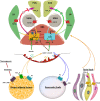Metabolic Changes Induced by Purinergic Signaling: Role in Food Intake
- PMID: 33995077
- PMCID: PMC8117016
- DOI: 10.3389/fphar.2021.655989
Metabolic Changes Induced by Purinergic Signaling: Role in Food Intake
Abstract
The purinergic signalling has a well-established role in the regulation of energy homeostasis, but there is growing evidence of its implication in the control of food intake. In this review, we provide an integrative view of the molecular mechanisms leading to changes in feeding behaviour within hypothalamic neurons following purinergic receptor activation. We also highlight the importance of purinergic signalling in metabolic homeostasis and the possibility of targeting its receptors for therapeutic purposes.
Keywords: food intake; metabolic homeostasis; obesity; orexigen and anorexigen neurons; purinergic receptors.
Copyright © 2021 Caruso, Zuccarini, Di Iorio, Muhammad and Ronci.
Conflict of interest statement
The authors declare that the research was conducted in the absence of any commercial or financial relationships that could be construed as a potential conflict of interest.
Figures

Similar articles
-
Sex-Biased Physiological Roles of NPFF1R, the Canonical Receptor of RFRP-3, in Food Intake and Metabolic Homeostasis Revealed by its Congenital Ablation in mice.Metabolism. 2018 Oct;87:87-97. doi: 10.1016/j.metabol.2018.07.003. Epub 2018 Jul 31. Metabolism. 2018. PMID: 30075164
-
Y2 receptor signalling in NPY neurons controls bone formation and fasting induced feeding but not spontaneous feeding.Neuropeptides. 2016 Feb;55:91-7. doi: 10.1016/j.npep.2015.09.009. Epub 2015 Sep 28. Neuropeptides. 2016. PMID: 26444586
-
Hypothalamic integration of immune function and metabolism.Prog Brain Res. 2006;153:367-405. doi: 10.1016/S0079-6123(06)53022-5. Prog Brain Res. 2006. PMID: 16876587 Free PMC article. Review.
-
Enhanced food intake after stimulation of hypothalamic P2Y1 receptors in rats: modulation of feeding behaviour by extracellular nucleotides.Eur J Neurosci. 2006 Oct;24(7):2049-56. doi: 10.1111/j.1460-9568.2006.05071.x. Eur J Neurosci. 2006. PMID: 17067301
-
Hypothalamic Wnt Signalling and its Role in Energy Balance Regulation.J Neuroendocrinol. 2016 Mar;28(3):12368. doi: 10.1111/jne.12368. J Neuroendocrinol. 2016. PMID: 26802435 Free PMC article. Review.
Cited by
-
Multipotent Stromal Cells from Subcutaneous Adipose Tissue of Normal Weight and Obese Subjects: Modulation of Their Adipogenic Differentiation by Adenosine A1 Receptor Ligands.Cells. 2021 Dec 17;10(12):3560. doi: 10.3390/cells10123560. Cells. 2021. PMID: 34944069 Free PMC article.
-
Hematopoiesis Revolves Around the Primordial Evolutional Rhythm of Purinergic Signaling and Innate Immunity - A Journey to the Developmental Roots.Stem Cell Rev Rep. 2024 Apr;20(3):827-838. doi: 10.1007/s12015-024-10692-9. Epub 2024 Feb 16. Stem Cell Rev Rep. 2024. PMID: 38363476 Free PMC article. Review.
-
Adenine-induced animal model of chronic kidney disease: current applications and future perspectives.Ren Fail. 2024 Dec;46(1):2336128. doi: 10.1080/0886022X.2024.2336128. Epub 2024 Apr 4. Ren Fail. 2024. PMID: 38575340 Free PMC article. Review.
-
Cell Type-Specific Expression of Purinergic P2X Receptors in the Hypothalamus.Int J Mol Sci. 2025 May 22;26(11):5007. doi: 10.3390/ijms26115007. Int J Mol Sci. 2025. PMID: 40507818 Free PMC article. Review.
References
Publication types
LinkOut - more resources
Full Text Sources
Other Literature Sources

